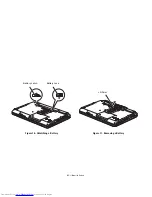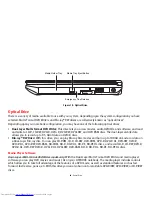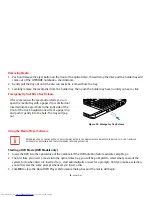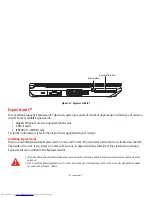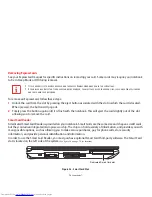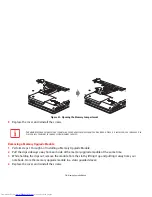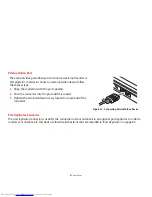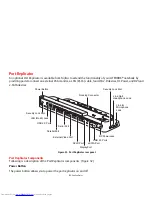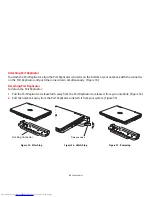
75
- Memory Upgrade Module
Memory Upgrade Module
Your Fujitsu notebook comes with high speed Double Data Rate Synchronous Dynamic RAM (DDR3-1600 SDRAM) factory
installed. To increase your memory capacity, you may install an additional memory upgrade module. The memory
upgrade must be a dual-in-line (DIMM) SDRAM module. To ensure 100% compatibility, purchase the SDRAM module
only from the Fujitsu web store at www.shopfujitsu.com
.
Installing Memory Upgrade Modules
1
Turn off power to your notebook, remove any power adapter (AC or auto/airline). Remove the battery.
2
Make sure that all the connector covers are closed.
3
Turn the notebook bottom side up, and remove the screw from the memory upgrade module compartment.
4
Remove the cover.
5
Remove the memory upgrade module from the static guarded sleeve.
6
Align the memory upgrade module with the part side up. Align the connector edge of the memory upgrade
module with the connector slot in the compartment. Note that the memory modules will be “stacked” when both
are installed.
7
Insert the memory upgrade module at a 45° angle (Figure 26). Press the connector edge of the module firmly
down and into the connector until it lodges under the retaining clip. You’ll hear a click when it is properly in place.
•
D
O
NOT
REMOVE
ANY
SCREWS
FROM
THE
MEMORY
UPGRADE
MODULE
COMPARTMENT
EXCEPT
THE
ONES
SPECIFICALLY
SHOWN
IN
THE
DIRECTIONS
FOR
INSTALLING
AND
REMOVING
THE
MEMORY
UPGRADE
MODULE
.
•
T
HE
MEMORY
UPGRADE
MODULE
CAN
BE
SEVERELY
DAMAGED
BY
ELECTROSTATIC
DISCHARGE
(ESD). T
O
MINIMIZE
RISK
TO
THE
MODULE
,
OBSERVE
THE
FOLLOWING
PRECAUTIONS
:
-
B
EFORE
HANDLING
A
MEMORY
MODULE
,
TOUCH
A
GROUNDED
METAL
OBJECT
TO
DISCHARGE
STATIC
ELECTRICITY
BUILT
UP
IN
YOUR
BODY
.
-
W
HEN
INSTALLING
OR
REMOVING
A
MEMORY
MODULE
,
HOLD
IT
BY
THE
EDGE
SO
AS
NOT
TO
TOUCH
ANY
CONTACTS
OR
CHIPS
. B
E
CAREFUL
NOT
TO
TOUCH
ANY
INTERNAL
TERMINALS
OR
COMPONENTS
;
THE
OIL
FROM
YOUR
FINGERS
COULD
CAUSE
A
SHORT
TO
THE
COMPONENTS
.
-
B
E
SURE
TO
POWER
DOWN
YOUR
SYSTEM
BEFORE
ADDING
OR
REMOVING
MEMORY
MODULES
. E
VEN
IF
THE
SYSTEM
IS
IN
HIBERNATE
OR
SLEEP
STATES
,
DATA
COULD
BE
LOST
OR
THE
MEMORY
COULD
BE
DAMAGED
IF
POWER
IS
STILL
AVAILABLE
TO
THE
SYSTEM
.



